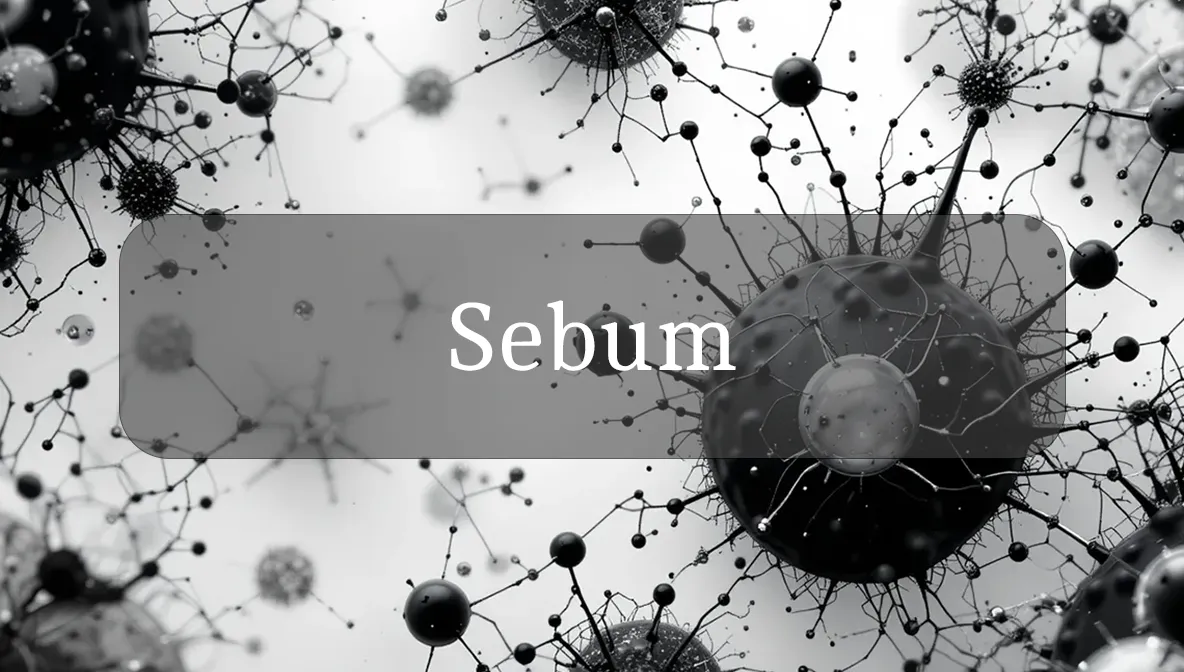Skin’s Natural Moisturizer for Protection and Balance
Sebum is like your skin’s built-in conditioner, a waxy oil that keeps your skin and hair hydrated, soft, and protected. Produced by sebaceous glands, it’s a key player for health-conscious folks aiming to maintain a healthy complexion and overall vitality. Understanding sebum can empower you to make choices that support your skin’s barrier and wellness. Let’s explore what sebum is, why it matters, and how you can nurture its function for daily vitality!
Chemical Identity and Type
Sebum is a complex lipid mixture, primarily composed of triglycerides, wax esters, squalene, cholesterol, and free fatty acids. It’s secreted by sebaceous glands, found in the dermis of the skin, especially on the face, scalp, and upper back. Sebum coats the skin and hair, forming a protective film that maintains moisture and flexibility. Think of it as your skin’s natural lotion, sealing in hydration and shielding against external threats.
Biological Role and Benefits
Sebum is a cornerstone of your skin and hair health, offering these benefits:
- Skin Hydration: It prevents water loss, keeping skin soft, supple, and free from dryness or flaking.
- Barrier Protection: Sebum forms a shield against environmental damage, UV rays, and pathogens, reducing infection risk.
- Hair Health: It lubricates hair shafts, enhancing shine, flexibility, and resistance to breakage.
- Antimicrobial Defense: Free fatty acids in sebum have antibacterial properties, protecting against acne-causing bacteria.
- Skin Flexibility: It maintains skin elasticity, reducing irritation and supporting a smooth complexion.
Balanced sebum levels keep your skin radiant, hair glossy, and barrier strong, enhancing overall vitality.
Dietary or Natural Sources
Your body produces sebum naturally, driven by hormones (androgens) and using lipids from your diet. You don’t get sebum directly from food, but you can support its production and balance with these nutrient-rich choices:
- Healthy Fats: Avocados, nuts, olive oil, and fatty fish (rich in omega-3s) provide lipids for sebum synthesis and reduce inflammation.
- Vitamin A-Rich Foods: Carrots, sweet potatoes, and spinach support skin cell turnover and sebaceous gland function.
- Zinc-Rich Foods: Oysters, pumpkin seeds, and beef regulate sebum production, helping prevent excess oiliness.
- Antioxidant-Rich Foods: Berries, green tea, and tomatoes protect skin from oxidative stress, preserving sebum’s protective role.
A balanced diet with healthy fats and micronutrients supports optimal sebum production.
Signs of Imbalance or Dysfunction
Sebum imbalances—too much or too little—may show up as:
- Excess Sebum (Oily Skin):
- Shiny, greasy skin, especially on the face (T-zone).
- Clogged pores, acne, or blackheads.
- Scalp oiliness or greasy hair.
- Low Sebum (Dry Skin):
- Dry, flaky, or rough skin.
- Itching, redness, or irritation.
- Dull, brittle hair or flaky scalp.
- Hormonal Imbalances: Acne flare-ups or oiliness tied to puberty, menstrual cycles, or stress.
- Skin Sensitivity: Increased infections or irritation from a weakened barrier.
These symptoms can have many causes, so if they persist, consult a healthcare provider to explore skin or hormonal issues.
Supporting Optimal Levels or Function
To balance sebum production and maintain healthy skin, try these evidence-based tips:
- Eat a Balanced Diet: Include salmon, nuts, or leafy greens to provide lipids and zinc for sebum regulation.
- Cleanse Gently: Use mild, non-comedogenic cleansers to remove excess sebum without stripping skin, preventing dryness or rebound oiliness.
- Moisturize Daily: Apply lightweight, oil-free moisturizers to support skin hydration, even for oily skin, to balance sebum production.
- Manage Stress: Meditation, yoga, or deep breathing lower cortisol, which can trigger excess sebum during stress.
- Protect Skin: Use broad-spectrum sunscreen (SPF 30+) to shield skin from UV damage, which can disrupt sebum function.
Small, consistent habits create a sebum-friendly environment for radiant, balanced skin.
Safety, Interactions, and Precautions
Sebum is a natural oil and safe when balanced, but consider these factors:
- Skin Conditions: Acne, rosacea, or seborrheic dermatitis often involve sebum dysregulation and may require dermatological care.
- Hormonal Issues: Conditions like PCOS or thyroid disorders can affect sebum production, needing medical management.
- Skincare Products: Harsh cleansers or alcohol-based products can strip sebum, causing dryness or overproduction. Choose gentle formulas.
- Supplements: Zinc or omega-3 supplements may support sebum balance but can cause side effects like nausea in high doses. Consult a healthcare provider before use.
Protecting sebum balance means supporting skin health and avoiding harsh treatments or hormonal triggers.
Fun Fact
Did you know sebum is unique to each person, like a fingerprint? Its exact composition varies, giving your skin its own signature scent and feel, tailored just for you!
Citations
- National Institutes of Health (NIH): Sebum and Skin Barrier Function.
- Mayo Clinic: Acne and Skin Health.
- Cleveland Clinic: Nutrition and Skin Wellness.
- World Health Organization (WHO): Diet and Skin Health Guidelines.
- USDA: Dietary Guidelines for Americans – Healthy Fat Diets.

